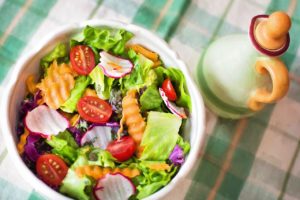Could Candida Be Causing Your child’s ADD/ADHD symptoms and Behavioral Issues?
In the past I experienced plenty of vaginal yeast infections. But I never, back then, knew the damage that candida can do to the body and how often, it not isolated to just one body part, such as in the mouth with oral thrush. It is a sneaky, pervasive yeast, that can spread and grow rapidly given the right conditions.
I learned this first hand when my son experienced a terrible case of candida.
I am sure you have heard of the term before, but do you know what it really means. If you ask your doctor he or she may tell you it means yeast overgrowth in the mouth (oral thrush) or a vaginal yeast infection. But systemic candida? Your doctor probably will tell you it does not exist. To be fair, candida isn’t something that is focused on in medical school.
But coming from personal experience and as a nutritionist I am here to tell you it does exist, and it can cause an array of symptoms.
If your child is acting out, seems hyperactive or has behavioral issues you may want to continue reading this blog. If your child has had several or more ear infections and has been on antibiotics than this article is also for you.
What Is Candida?
In our intestinal tract we naturally have microorganisms or bacteria called lactobacilli, as well as yeast. They coexist in harmony unless we upset the natural balance by eating too much of certain food items such as sugar or by taking antibiotics. Any significant imbalance to this normal gut flora can lead to illness and yeast overgrowth. Again, most people think of a yeast infection as a localized issue, but the truth of the matter is that yeast excretes a toxin that can then travel via the blood to any site in the body.
Candida also weakens the normal intestinal membrane, creating leaky gut which is essentially toxins and food particle passing through the membrane and traveling to other parts of the body. This process can also lead to an increased chance of the child developing food allergies. This can then result in nasal congestion, abdominal pain and other symptoms that can also affect the child’s nervous system and mental health.
For more information on .leaky gut read this article
What Are Some Additional Symptoms of a Yeast Infection?
First let’s look at some of the symptoms of candida to see if any of this sounds like your child. I did not include specific ADD/ADHD symptoms since we are looking at symptoms in addition to those presented in ADD/ADHD. However, most candida symptom lists will include the symptoms of ADD/ADHD
- Fatigue
- Fibromyalgia
- Irritable when hungry
- Headaches
- Brain fog, Forgetfulness
- Diarrhea, gas, bloating, constipation
- Sore throat, chronic, or constant clearing of the throat
- Athletes foot
- Cravings for sugar, white refined food products, processed simple carbs such as bread and other white flour products,
- Painful cracks at the corners of the mouth
- Difficulty with sleep
- Painful joints
- Acne, skin rashes, psoriasis
- Bronchitis, pneumonia, asthma
- In children especially-toe walking, repetitive gestures or behaviors, decreased eye contact, not engaged, inappropriate laughter, repeating phrases from books, movies (as if from a script)
- Autism
- White coated tongue
- Sensitive to smells such as perfumes, cigarettes, the cleaning product aisle in stores or the perfume section of stores
- Anxiety
- IBS, IBD
- Genital touching in young children
- Angry easily
- Chronic bladder infections
- Oral thrush
- Chronic bad odor of feet and/or hair in children
- Chronic bad breath
*please note that the above symptoms may not be related to candida and can also be related to other health issues as well.
Does this sound like your child?
Note that usually it is not just one thing that causes the candida but several causes. The most common cause of candida in children is chronic ear infections treated with antibiotics.
Candida Causes
- Corticosteroids such as prednisone
- Birth control pills
- Chronic stress (yes, even children can experience chronic stress)
- Refined diet, Standard American diet, diet high in sugar
- Mercury dental fillings
- Nutrient deficiencies such as biotin, selenium or zinc (low zinc can be related to elevated copper and elevated copper can also cause candida)
- Chronic use of antibiotics, consuming antibiotics by eating CAFO (confined animal factory operations) meat and dairy products, even just one round of antibiotics can cause candida.
- (Unknown) Food allergies/sensitivities (look for red ear lobes, red ears, rosy cheeks, dark or red circles under the eyes, or wrinkles under the eyes)
- Heartburn, reflux, GERD, low stomach acid
- Acid suppressing drugs such as PPI’s, OTC antacids
- Chronic colds or viral infections
- Congested liver, reduced bile (hint: take a look at your child’s stool-is it brown or tan? If it is tan this is indicative of low bile flow)
- Frequent use of non-calorie sweeteners (read labels, it is hidden everywhere!)
Testing
At home spit test: while this is not as accurate as a lab test, this is a good place to start, along with the questionnaire.
To do the spit test: when your child wakes up in the morning, have her before she brushes her teeth or eats or drinks anything, spit into a glass of filtered room temperature water. Come back every 20 minutes for the next hour to check it. You are looking for strings coming down through the water, from the saliva, cloudy saliva sitting at the bottom of the glass and opaque specks of saliva suspended in the water. You are looking for at least one of these things. You may notice one of these within the first 5 minutes. Many will say this is not an accurate test, so use this just as an at home test but not the definitive test.
If you want to assist your child with the candida Questionnaire, it can be found here at www.yeastconnection.com. Click on resources and it will lead you to the quiz.
You can order a blood test called Candida Albicans Antibodies (IgG, IgA, IgM) for $99 through me. Click here to order the test at Direct Labs. Beyond that, your child may need food sensitivity testing.
What to Do Once You Have Determined That Your Child Has Candida
The candida protocol involves rotating specific supplements, adding in pro and prebiotics; consuming a diet of whole foods consisting mostly of quality proteins, leafy greens and vegetables and using foods and supplements to boost the immune system and heal the gut.
The first place to start is with diet. Look at the diet of your child. Does it contain sugary beverages, refined grains, sugary and starchy snacks and candy? Ideally you want to make changes to the diet first but more importantly when doing so the entire family has to be on board. Meaning, that you can’t tell your child he cannot have soda while you are in front of him drinking a can of coke. It means making changes (for the better) for the household, cleaning out the pantry and explore using new recipes.
It can be done. If this seems overwhelming to you, enlist help of an expert. Many nutritionists come to the home to do pantry makeovers or go on shopping outings with you to show you what to buy and avoid. Go here and here and here and here if you need more help and support.
Replace the junk food and processed food with whole food. Think “Just Eat Real Food”. Include more vegetables, proteins and healthy fats in the diet. Make homemade snacks for the kids using almond and coconut flour and stevia or monk fruit instead of processed sugar.
Read labels, not just want the brands want you to read on the front of the package.
Refined, processed carbs convert into sugar as soon as they enter the blood stream. That cereal and milk in the morning-all sugar. The lunch of a sandwich, and fruit gummies-sugar. Pasta and bread for dinner-sugar.
The next step is to start adding in herbs that can kill off the overgrowth of yeast. Herbs would include Pau D’Arco, allicin from garlic, caprylic acid, grape fruit seed extract, oregano oil, olive leaf extract and others-rotating these herbs, so using only one for 5 days and then switching over to a different herb. The length of time for use depends on the severity of the yeast problem. Many also need to add in enzymes that break up the biofilm that surrounds candida.
For more information on what to take for candida, read this article on candida and mental health
Next you would want to add in probiotics from fermented foods and supplements. If using a supplement, use one that also has prebiotics in it or by a prebiotic supplement in addition to the probiotic. If getting probiotics from food sources avoid dairy during the yeast cleanse period since it is high in sugar. Fermented foods such as fermented sauerkraut or fermented vegetables are good choices to add in. Avoid kombucha for now due to the sugar content.
Find a quality nutritionist who can support you as this may seem overwhelming but does not need to be. A nutritionist should be able to break this down into easy doable steps for the child and the family.
And be patient! With my own son, I admit, the first few months were rough, but then we got the hang of it. We stuck to a candida protocol for a year and it was well worth it!
So yes, I have been through this and yes, at first it was a bit overwhelming but that’s because back in the 1990’s I did not have access to all the information and wonderful holistic mentors that exist today! I also did not have access to all the amazing food choices we have today nor the supplements or the information that is available.
Bottom Line: If your child is struggling with behavioral issues, ADHD like behavior and other health issues, it is time to start looking deeper. If candida is not obvious, as it was in my son’s case, I suggest testing.
Sources
Balch, P. (2012) Prescription for Herbal Healing. 2nd Edition. NY: Avery.
Bauman, E. & Friedlander, J. (2014). Therapeutic Nutrition. CA: Bauman College.
Gaby, A. (2011). Nutritional Medicine. NH: Fritz Perlberg Publishing.
Gaby, A., et. al. ( 2006)The Natural Pharmacy. Revised and Updated 3rd Edition. NY: Three
Rivers Press.
Marz, R.(1999) Medical Nutrition. 2nd Edition. OR: Omni Press





Leave A Comment
You must be logged in to post a comment.